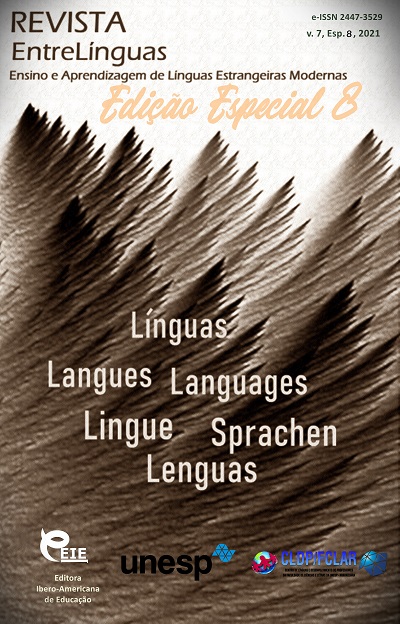Functional aspects of indeterminacy category and invariant study of polysemous words
DOI:
https://doi.org/10.29051/el.v7iesp.8.16357Keywords:
Markers of indeterminacy, Indeterminate noun groups, Polysemous words, Lexical invariant, MeaningAbstract
The article shows how language consciousness forms semantic unities and individualities in its mental lexicon. The article typologies and lists the functions of indeterminacy markers in English and Russian. The category of indeterminacy is juxtaposed to the problem of polysemous word representation at the lexicon level. We focus our attention on the contextless general representative of a polysemous word's structure, called its "lexical invariant". The invariant is a generalized experience of the word's contextual realizations, narrowing its semantic components to dominant and stable necessary minimums that stand behind conceptualization and formation of new meanings. Empirical invariant-component analysis of English polysemous words “a leg”, “a cheek”, “a knee” serve as examples of the invariant's functioning. The analysis allowed us to determine the invariants of these words as collections of base dominant components of a word's semantic nucleus. In speech context, an invariant takes shape as one of its combinatorial variants.
Downloads
References
[ACD] (1951). American College Dictionary. New York. Random house.
[NWDEL] (1989). New Webster¢s Dictionary of English Language. College ed. - 4th repr. Dehli: Surgeet Publications.
[WTHID] – (1961). Websters Third New International Dictionary. – Springfield (Mass) Mer-riam co.
Channell, J. (1994). Vague Language. – New York: Oxford University Press. P. 238.
Channell, J. (1994). Vague Language. – Oxford: Oxford University Press,
CREE, G.S., MCRAE, K. (2003). Analysing the factors underlying the structure and compu-tation of the meaning of chipmunk, cherry, chisel, cheese and cello (and many other concrete nouns). Journal of Experimental Phycology: General. Vol.132. P. 163-201.
GALSWORTHY, J. (1994). The Man of Property. Hertfordshire: Wordsworth Editions. P. 22.
KELLO, C.T., PLAUT, D.C. (2004). A neuro network model of the articulary-acoustic forward mapping trained on recordings of articulatory parameters. Journal of the Acoustical Society of America, 2354-2364.
KOSTINA, N., ZERKINA, N., PESINA, S. (2015). Polysemous Words Functioning and Process of Concept Formation // Procedia - Social and Behavioral Sciences, 192, 24, 690-694.
LYONS, J. (1981). Language, Meaning and Context. - London: Fontana Linguistics. P 238.
MARTYNOVA, I.A. (2016). Leksicheskie markery neopredelennosti v razgovornom an-glojazychnom diskurse (Lexical Markers of Indeterminacy in Spoken English Dis-course). Vestnik VGU, 2, 30–34. [in Russian]
PESINA, S., PULEKHA, I., TANDON, P. (2019). Functional Peculiar properties of Lexical Markers in the English Language, Gumanitarno-pedagogicheskie issledovaniya [Humanitarian and pedagogical Research], 3(1), 76 81. [in Russian]
PESINA, S., LATUSHKINA, O. (2015). Polysemy and Cognition. Procedia - Social and Be-havioral Sciences, 192, 24, 86 – 490.
PESINA, S., YUSUPOVA, L. (2015). Words Functioning in Lexicon. Procedia - Social and Behavioral Sciences, 192, 24, 38 – 43.
SALINGER, J. D. (2011). The Catcher in the Rye. Penguin.
SOLONCHAK, T., PESINA, S. (2015). Lexicon Core and Its Functioning. Procedia - Social and Behavioral Sciences, 192, 24, 481 – 485.
Downloads
Published
How to Cite
Issue
Section
License

This work is licensed under a Creative Commons Attribution-NonCommercial-ShareAlike 4.0 International License.
Os manuscritos aceitos e publicados são de propriedade da Revista EntreLínguas. Os artigos publicados e as referências citadas na Revista EntreLínguas são de inteira responsabilidade de seus autores.
Transferência de direitos autorais – autorização para publicação
Caso o artigo submetido seja aprovado para publicação, já fica acordado que o(s) autor(es) autoriza(m) a UNESP a reproduzi-lo e publicá-lo na EntreLínguas, entendendo-se os termos “reprodução” e “publicação” conforme definição respectivamente dos incisos VI e I do artigo 5° da Lei 9610/98. O artigo poderá ser acessado pela rede mundial de computadores (Internet), sendo permitidas, a título gratuito, a consulta e a reprodução de exemplar do artigo para uso próprio de quem a consulta, desde que haja a citação ao texto consultado. Essa autorização de publicação 328 EntreLínguas, Araraquara, v. 1, n .2, p. 323-328, jul./dez. 2015 não tem limitação de tempo, ficando a UNESP responsável pela manutenção da identificação do(s) autor(es) do artigo. Os artigos publicados e as referências citadas na Revista EntreLínguas são de inteira responsabilidade de seus autores.











